Related Research Articles

Odia is an Indo-Aryan language spoken in the Indian state of Odisha. It is the official language in Odisha, where native speakers make up 82% of the population, and it is also spoken in parts of West Bengal, Jharkhand, Andhra Pradesh and Chhattisgarh. Odia is one of the many official languages of India; it is the official language of Odisha and the second official language of Jharkhand. The language is also spoken by a sizeable population of 700,000 people in Chhattisgarh.

Santali, Bengali: সাঁওতালী, Odia: ସାନ୍ତାଳୀ, Devanagari: सान्ताली, also known as Santal, is the most widely-spoken language of the Munda subfamily of the Austroasiatic languages, related to Ho and Mundari, spoken mainly in the Indian states of Assam, Bihar, Jharkhand, Mizoram, Odisha, Tripura and West Bengal. It is a recognised regional language of India per the Eighth Schedule of the Indian Constitution. It is spoken by around 7.6 million people in India, Bangladesh, Bhutan and Nepal, making it the third most-spoken Austroasiatic language after Vietnamese and Khmer.

The Magahi language, also known as Magadhi, is a language spoken in Bihar, Jharkhand and West Bengal states of eastern India, and in the Terai of Nepal. Magadhi Prakrit was the ancestor of Magahi, from which the latter's name derives.
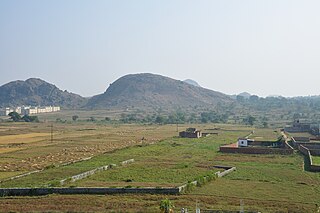
The Chota Nagpur Plateau is a plateau in eastern India, which covers much of Jharkhand state as well as adjacent parts of Chhattisgarh, Odisha, West Bengal and Bihar. The Indo-Gangetic plain lies to the north and east of the plateau, and the basin of the Mahanadi river lies to the south. The total area of the Chota Nagpur Plateau is approximately 65,000 square kilometres (25,000 sq mi).

The Kharia are an Austroasiatic tribal ethnic group from east-central India. They originally speak the Kharia language, which belong to Austroasiatic languages. They are sub-divided into three groups known as the Hill Kharia, Delki Kharia and the Dudh Kharia. Amongst them, the Dudh Kharia is the most educated community.
Kurukh, also Kurux, Oraon or Uranw, is a Dravidian language spoken by the Kurukh (Oraon) and Kisan people of East India. It is spoken by about two million people in the Indian states of Jharkhand, Chhattisgarh, Odisha, West Bengal, Assam, Bihar and Tripura, as well as by 65,000 in northern Bangladesh, 28,600 of a dialect called Uranw in Nepal and about 5,000 in Bhutan. Some Kurukh speakers are in Andaman and Nicobar Islands. It is most closely related to the Malto language. It is marked as being in a "vulnerable" state in UNESCO's list of endangered languages. The Kisan dialect has 206,100 speakers as of 2011.

Singhbhum was a district of India during the British Raj, part of the Chota Nagpur Division of the Bengal Presidency. It was located in the present-day Indian state of Jharkhand. Chaibasa was the district headquarters. Located in the southern limit of the Chota Nagpur Plateau, Singhbhum included the Kolhan estate located in its southeastern part. The district has been divided into three smaller districts, being East Singhbhum, West Singhbhum and Saraikela Kharsawan all are present in Jharkhand state of India. This district of Jharkhand is one of the leading producer of copper in India.
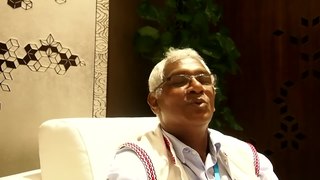
The Kharia language is a Munda language of the Austroasiatic language family, that is primarily spoken by the Kharia people of eastern India.

Toto is a Sino-Tibetan language spoken on the border of India and Bhutan, by the tribal Toto people in Totopara, West Bengal along the border with Bhutan. It is also spoken in Subhapara, Dhunchipara, and Panchayatpara hillocks on India-Bhutan border in Jalpaiguri district, West Bengal (Ethnologue).

Nagpuri is an Indo-Aryan language spoken in the Indian states of Jharkhand, Chhattisgarh, Odisha and Bihar. It is primarily spoken in the west and central Chota Nagpur plateau region. It is sometimes considered a dialect of Bhojpuri.
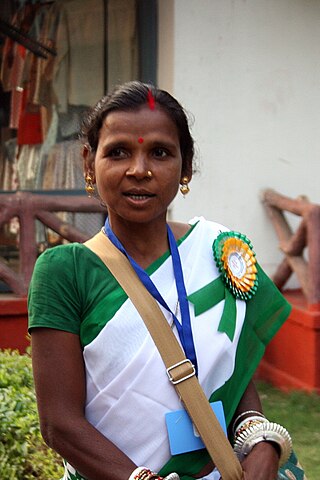
The Ho people are an Austroasiatic Munda ethnic group of India. They call themselves the Ho, Hodoko and Horo, which mean 'human' in their own language. Officially, however, they are mentioned in different subgroups like Kolha, Mundari, Munda, Kol and Kolah in Odisha. They are mostly concentrated in the Kolhan region of Jharkhand and Odisha where they constitute around 10.7% and 7.3% of the total Scheduled Tribe population respectively, as of 2011. With a population of approximately 700,000 in the state in 2001, the Ho are the fourth most numerous Scheduled tribe in Jharkhand after the Santals, Kurukhs, and Mundas. Ho also inhabit adjacent areas in the neighboring states of Odisha, West Bengal and Bihar bringing the total to 806,921 as of 2001. They also live in Bangladesh and Nepal.

Mundari (Munɖari) is a Munda language of the Austroasiatic language family spoken by the Munda tribes in eastern Indian states of Jharkhand, Odisha and West Bengal. It is closely related to Santali. Mundari Bani, a script specifically to write Mundari, was invented by Rohidas Singh Nag. It has also been written in the Devanagari, Odia, Bengali, and Latin writing systems.
The Birhor language is a highly endangered Munda language spoken by the Birhor people in Chhattisgarh, Odisha, West Bengal, and Maharashtra states in India.
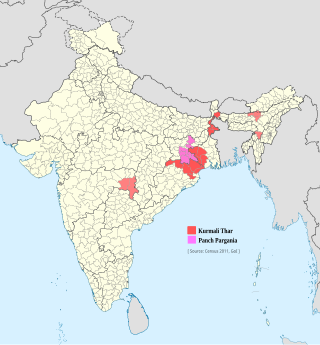
Kurmali or Kudmali is an Indo-Aryan language classified as belonging to the Bihari group of languages spoken in eastern India. As a trade dialect, it is also known as Panchpargania, for the "five parganas" of the region it covers in Jharkhand. Kurmali language is spoken by around 5.5 lakh people mainly in fringe regions of Jharkhand, Odisha and West Bengal, also a sizable population speak Kurmali in Assam tea valleys. Intellectuals claim that Kurmali may be the nearest form of language used in Charyapada. Kurmali is one of the demanded languages for enlisting in Eighth Schedule to the Constitution of India.
Most of the languages of Bihar, one of north India's most populous states, belong to the Bihari subgroup of the Indo-Aryan family. Chief among them are Bhojpuri, spoken in the west of the state, Maithili in the north, and Magahi in the south. Of these, only Maithili has official recognition under the Eighth Schedule to the Constitution of India. The official language of Bihar is Hindi, with Urdu serving as a second official language in 15 districts.
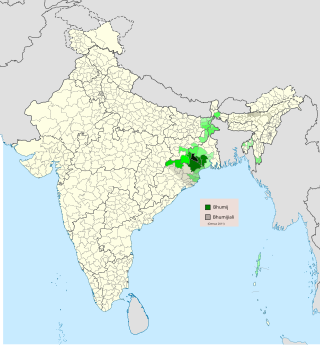
Bhumij is an Austroasiatic language belonging to the Munda subfamily, related to Ho, Mundari, and Santali, primarily spoken by Bhumij peoples in the Indian states Jharkhand, Odisha and West Bengal. As per the 2011 census, only 27,506 people out of 9,11,349 Bhumij people spoke Bhumij as their mother tongue, as most Bhumijas have shifted to one of the regional dominant languages. Thus the language is considered an extremely endangered language.
Turi is an endangered Munda language of India that is closely related to Mundari. It is spoken by only half a percent of ethnic Turi, the rest having shifted to Sadri in Jharkhand, Mundari in West Bengal, and Odia in Odisha. The Turi are classified as a Scheduled Caste in Jharkhand.
The Birjia language, also known as Binjhia or Bijori, is a language of India. It is commonly assumed to be a Munda language closely related to the Asuri language. However, Anderson, based on Prasad (1961:314), suggests that Birjia (Binjhia) may be an Indo-Aryan language, although the Birjia are a tribe of the Asuri nation. The latter include the Asur and the Agariya.
Khortha or alternatively classified as Eastern Magahi is a language which is considered dialect of Magahi language spoken in the Indian state of Jharkhand, mainly in 16 districts of two divisions: North Chotanagpur and Santhal Pargana. Khortha is spoken by the Sadaans as native language and used by the tribal as a link language. It is most spoken language of Jharkhand.
The Nagpuria people, also Nagpuri or Sadan, are an Indo-Aryan speaking ethnolinguistic group who are the native speakers of the Nagpuri language and natives of the western Chota Nagpur Plateau region of Indian states of Jharkhand, Bihar, Chhattisgarh and Odisha.
References
- ↑ Asuri at Ethnologue (18th ed., 2015) (subscription required)
- ↑ Chaudhuri, Sarit Kumar & Chaudhuri, Sucheta Sen (2005). Primitive Tribes in Contemporary India: Concept, Ethnography and Demography, Volume 1, pp.50-59. Mittal Publications. ISBN 8183240267
- ↑ Prasad, Narmadeshwar (1961). Land and People of Tribal Bihar, p.305. Bihar Tribal Research Institute, Government of Bihar
- ↑ Baskaran, S. G. (2015). Consonant Sequence and Syllable Formation in Asuri. Language In India, 15(5), 23-34.
- 1 2 Baskaran, S. Ganesh (4 April 2015). "Phonemes of Asuri" (PDF). Language in India. 15. ISSN 1930-2940.
- ↑ Barik, Satyasundar (2020-02-15). "Radio aids revival of dying tribal language". The Hindu. ISSN 0971-751X . Retrieved 2022-03-03.